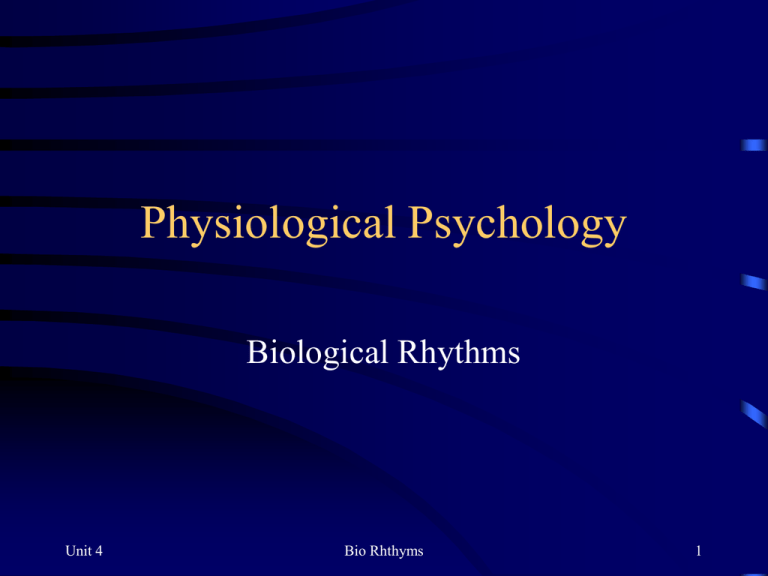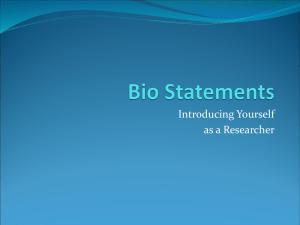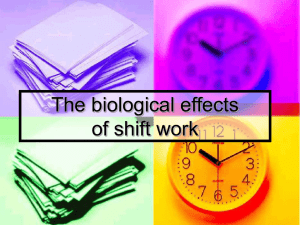
Physiological Psychology
Biological Rhythms
Unit 4
Bio Rhthyms
1
Unit 4
Bio Rhthyms
2
What is a bio-rhythm?
Which of the following diagrams would you
consider to be showing a rhythmic pattern?
Unit 4
Bio Rhthyms
3
What is a biological rhythm?
• A periodic change in
the behaviour or
physiology of animals
and plants
– (eg sleep, hibernation
and migration)
• People that study
biological rhythms are
known as
‘chronobiologists’
Unit 4
Bio Rhthyms
4
The Main Bio-Rhythms
1 Ultradian Rhythm
(less than 24 hours)
3 Infradian Rhythm
(1 month)
2 Circadian Rhythm
(24 hours)
4 Circannual Rhythms
(1 year)
Unit 4
Bio Rhthyms
5
The Circadian Rhythm
A daily
rhythmic
activity
cycle,
based on
24-hour
intervals
Unit 4
Bio Rhthyms
6
The Circadian Rhythm
• We have evolved to fit the 24 hour clock
• Even single celled organisms display a 24 hour
cycle
• Mammals have evolved to fit the cycle
– Nocturnal v Diurnal
• There are around 100 types of Circadian Cycles
(Green 1994)
• Most commonly known is sleep wake cycle
– Although this is different in infancy
Unit 4
Bio Rhthyms
7
Development of Circadian
Rhythms in Infancy
At what point
would you say the
infant’s rhythm
becomes
established?
Unit 4
Bio Rhthyms
8
ACTIVITY
• Describe your average day:
• What time do you wake? How do you feel?
• When do you get hungry? When do you
have lunch?
• When do you start to feel tired? When do
you go to sleep?
Unit 4
Bio Rhthyms
9
Unit 4
Bio Rhthyms
10
morning or night person?
The Night Owl
• Shows “morning
syndrome” i.e. awakens as
day goes on …
• Goes to bed late –
midnight or later
• Wakes late as possible in
morning
• Feels ‘ill’ if has to get up
at 6am
• Feels tired during the day
due to too little sleep
Unit 4
The Morning Lark
• Doesn’t show morning
syndrome
• Tends to wake early
before 7am
• Active soon after waking
• Struggles to stay up late
• Can fall asleep fast if goes
to bed early e.g. 9pm
Bio Rhthyms
11
Other Circadian Rhythms
•
•
•
•
Temperature regulation
Cognitive functioning
Pain tolerance
Certain illnesses are worse at different
times
• e.g. hay fever in the morning, or late at
night
• Chronotherapeutics address this
Unit 4
Bio Rhthyms
12
Key Study: Siffre
• Spent some time in a cave What day is it?
• Absence of all time givers
• Extended his circadian
cycle to approx 27 hours
• Spent 179 days in cave
(but he thought 151!)
• However, Lavie (2001)
puts the shift at only a few
minutes using careful
controls
Unit 4
Bio Rhthyms
13
The Circadian Shift
Unit 4
Bio Rhthyms
14
But what gives us our sense of
time?
Exogenous Zeitgeber
• Outside the body
• External cues
– (e.g. your alarm clock)
Endogenous Pacemaker
• Within the body
• Specific bio-chemical
changes
• Environmental stimuli
– (e.g. daylight,
temperature change)
Unit 4
Bio Rhthyms
– (e.g. melatonin, SCN,
pineal gland)
15
Suprachiasmic Nucleus (SCN)
Unit 4
Bio Rhthyms
16
The Suprachiasmic Nucleus
Unit 4
Bio Rhthyms
17
Endogenous Pacemakers
• small cluster of cells in
our hypothalamus
called the:
Suprachiasmatic
nucleus (SCN).
• linked to our visual
system
• influenced by the
amount of light we
detect.
Unit 4
Bio Rhthyms
18
Endogenous Pacemakers
• SCN can in turn cause
the
• pineal gland to
produce a hormone
called
• melatonin
• This can make you feel
sleepy.
Unit 4
Bio Rhthyms
19
24 Hours of Melatonin Secretion
Ok, what
conclusions
would you draw
from this chart.
Can you explain
why this happens?
Unit 4
Bio Rhthyms
20
The general scientific test for
endogenous rhythms
1. Place the organism into an environment devoid
of all external patterns
2. (e.g. constant light and temperature)
3. Observe if the rhythmic pattern continues.
4. This would be in a laboratory situation where a
constant environment is maintained.
5. Endogenous rhythms are usually coded in the
organisms DNA, and hence the endogenous
pattern is usually inheritable.
Unit 4
Bio Rhthyms
21
DeCoursey et al (2000)
• destroyed the SCN in
some chipmunks.
• found that these
chipmunks were much
more active at night
• however they were also
more likely to be taken by
nocturnal predators
• Support for the ecological
theory in sleep (more on
that later)
Unit 4
Bio Rhthyms
I may look cute, but
just because
researchers were a
bit cruel to me, you
can’t use that as an
evaluation!
22
Internet Resources
http://www.a-levelpsychology.co.uk/online/a2/chapter04/intex1.asp
an interactive resource on sleep-wake cycle
Unit 4
Bio Rhthyms
23
What about the following:
• Watching TV late at night?
• Staying indoors during the
winter?
•Summer
• Solar eclipse?
in Norway?
•Flying from San Francisco to London?
Unit 4
Bio Rhthyms
24
Disruption of Circadian Rhythms
• Jet Lag (Spitzer et.al.)
• Body is out of phase
• You think/feel it’s a
different time.
• Worse travelling from
the west to an eastern
time zone
– (e.g. Los Angeles to
London)
Unit 4
Bio Rhthyms
25
Prevention of Jet Lag
Using artificial doses of melatonin can reduce the
effect of jet lag
Unit 4
Bio Rhthyms
26
Internet resources
• http://www.alevelpsychology.co.uk/online/a2/chapter04/i
ntex2.asp
• An interactive resource on jet lag
Unit 4
Bio Rhthyms
27
Common Effects of Shift Work
• Lack of
communication
between staff
• Lack of ‘teamwork’
• Poorer concentration
on duty tasks
• Unsafe conditions
• Stress
• Shift lag
Unit 4
Bio Rhthyms
28
Shift Lag
• Mental symptoms:
– Increased irritability
– Overly emotional
– Forgetfulness
• Physical Symptoms:
– Fatigue
– Loss of energy
– Tiredness
Unit 4
Bio Rhthyms
29
Key Studies:
Monk & Folkard (1985)
• Interviewed workers
who regularly changed
shift
• Found changing shifts
was better for for:
• Subjective wellbeing
• Productivity
Unit 4
Bio Rhthyms
30
Key Studies: Czeisler (1982)
• Workers at a chemical
plant in Utah took 16 days
to adjust
• Conclusion; workers
should move forward in
time (clockwise)
• Job satisfaction increased
• Productivity rose
• Accident rates declined
• Workers report more
satisfaction in leisure time
Unit 4
Bio Rhthyms
31
Infradian Rhythms
• for more than one day
– e.g. the 28 day
menstrual cycle,
• Tied in closely to the
lunar month (the only
external cue).
• Evolutionary
adaptation?
• nocturnal predation
Unit 4
Bio Rhthyms
32
Menstruation
• Levels in female sex
hormones change
• Ovulation
• Pre-menstrual
syndrome
– (changes in female sex
hormones)
• Menstrual synchrony
– (pheromone cues)
Unit 4
Bio Rhthyms
33
Key study: Rienberg (1967)
• Studied girl in cave for 3
months
• Menstrual cycle shortened to
25.7 days
• Took a year to get back to
her normal cycle of 27 days
• (By the way, her day
lengthened to 24.6 hours –
support for Siffre)
Unit 4
Bio Rhthyms
34
Unit 4
Bio Rhthyms
35
The Ovulation Cycle
Unit 4
Bio Rhthyms
36
Ultradian rhythms
These are rhythms that are
shorter than a day. Such rhythms
occur during sleep, but other
ultradian rhythms include
excretion from the kidneys and
heart rate. People addicted to
nicotine will show an ultradian
rhythm — smoking!
Unit 4
Bio Rhthyms
37
Ultradian rhythms in sleep
Electroencephalogram (EEG) recordings
have revealed that the brain is still active
during sleep, but different states of awareness
have distinct patterns of electrical activity
associated with them in the normal individual.
Wakefulness, the immediate pre-sleep stage,
light sleep, deep sleep and periods of
dreaming (REM sleep) can all be identified
through EEG recording – all ultradian
rhythms!
Unit 4
Bio Rhthyms
38
Circannual Rhythms
• Male hamsters
testosterone levels change
over the year
• Breeding season triggered
by longer days
• Lesions in the SCN
disrupt this
• Testosterone is secreted
all year!
• (Rusak & Zuker 1975)
Unit 4
Bio Rhthyms
39
Fertility and Summer
• Reinberg (1967) study
in 600 german
schoolgirls
• They tend to start their
menstruation during
winter months
• Stable menstrual
cycles occur more in
summer, hence more
conceptions
Unit 4
Bio Rhthyms
40
Seasonal Affective Disorder
(S.A.D.)
•
•
•
•
•
•
Lack of daylight
Increases melatonin
Fatigue
Disordered sleep patterns
Risk of depression
Treated with UV light
and/or melatonin therapy.
– For more info follow the
link:
http://hcd2.bupa.co.uk/fact_sheets/html/sad.html
Unit 4
Bio Rhthyms
41








